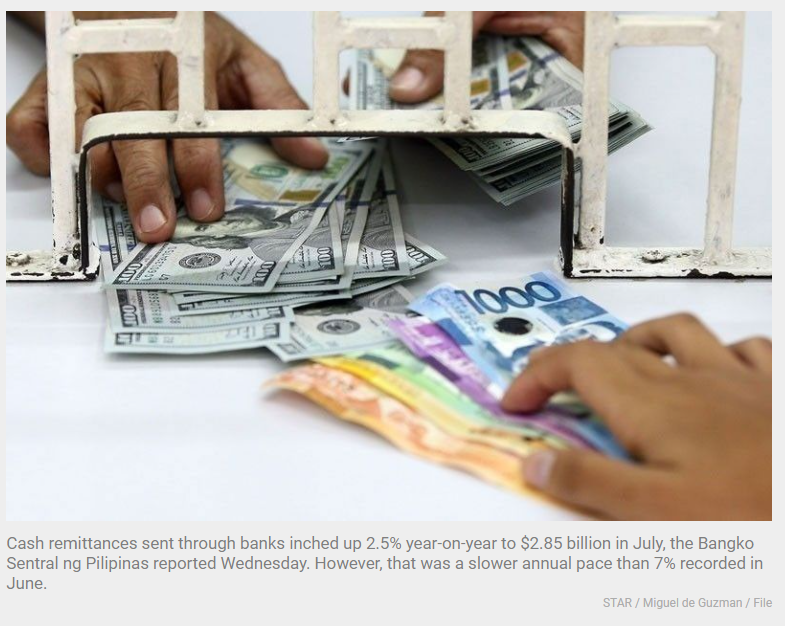Remittances, a lifeline for many Filipino families, post slower growth in July
MANILA, Philippines — Money sent home by Filipinos abroad continued to grow in July, albeit at a slower pace than the previous month, showing their time-tested resilience as the global economy slowly reopens from coronavirus lockdowns.
What’s new
Cash remittances sent through banks inched up 2.5% year-on-year to $2.85 billion in July, the Bangko Sentral ng Pilipinas reported Wednesday. However, that was a slower annual pace than 7% recorded in June.
In the first seven months, cash remittances went up 5.8% on-year to $17.8 billion.
Why this matters
Remittances have historically supported the Philippines’ consumption-driven economy, especially since money sent home by migrant Filipinos boosts the spending capacity of their families here.
At the same time, remittances serve as a key dollar source for the Philippines. For this year, the BSP forecast cash remittances to grow 4% that, if realized, would reverse last year’s 0.8% contraction when the pandemic triggered massive job losses worldwide.
What analysts say
Sought for comment, Jun Neri, lead economist at Bank of the Philippine Islands, said remittances would likely grow larger by the end of the year driven by cash sent home by Filipinos working in the hospitality sector overseas.
The fourth quarter is typically a strong period for remittances as Filipino expats send home money for the Christmas shopping season.
“I think the latest print is just a soft patch so that we will likely revert to the higher growth prints towards yearend. The recent global virus surge hasn’t translated to as many Covid-related deaths which means tours via cruise ships and similar activities will likely rebound,” Neri said in a Viber message.
The hospitality industry took one of the worst hits from the pandemic, especially since early documented cases of infections were aboard cruise ships. This has changed, Neri noted, as many Filipinos will likely “fill up” openings in the sector because many workers, especially those in US and Europe, are not rushing to retake these jobs.
Likewise, the return to normal for developed countries bodes well for the state of global labor, Jeremiah Opiniano, executive director at the Institute for Migration and Development Issues, said.
“It seems that overseas Filipinos have kind of adjusted already to the continuing impacts of the pandemic. I think we can also see that since some destination countries have slowly resumed normalcy and economic activities (amid the Delta variant threats), so there’s a semblance of renewed vigor for people to earn incomes,” Opiniano said in an online exchange.
Other figures
- The BSP said 40.4% of 7-month cash remittances came from United States, while the rest came from Singapore, Saudi Arabia, Japan, and the United Kingdom.
- Remittance from land-based workers inched up by 1.6% year-on-year to $2.31 billion in July. Sea-based workers brought in a total of $545 million, which grew 6.9% year-on-year.
Source: https://www.philstar.com/business/2021/09/15/2127322/remittances-lifeline-many-filipino-families-post-slower-growth-july


 Thailand
Thailand




